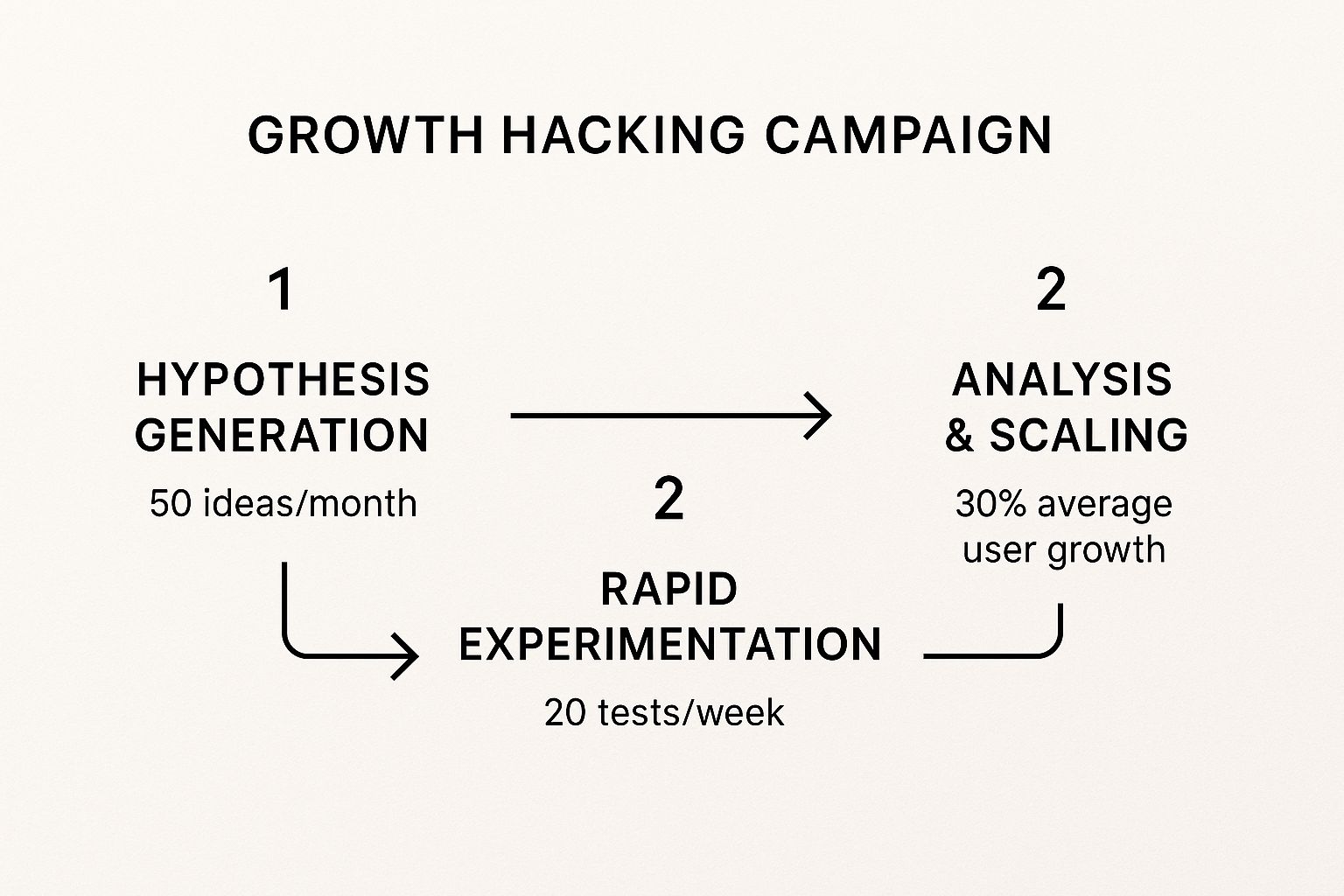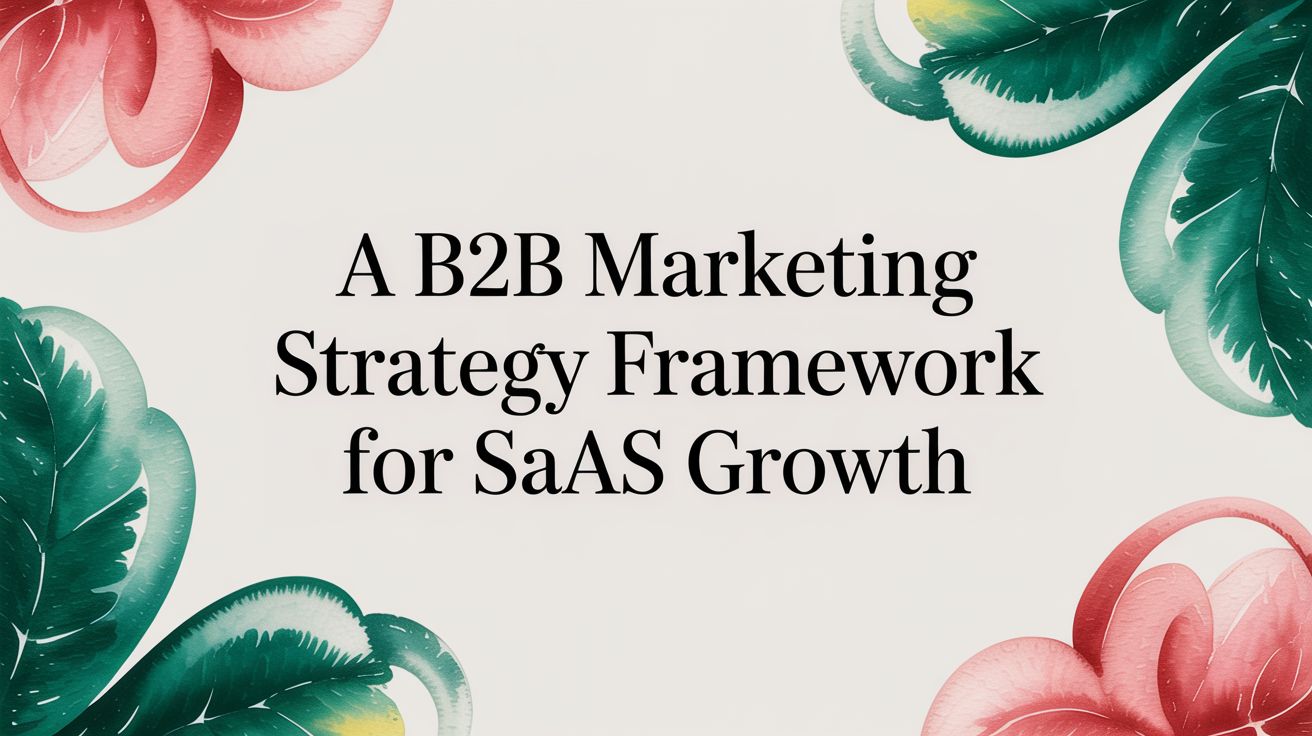What is Growth Hacking? Key Strategies for Rapid Growth
July 29, 2025

If you've spent any time in startup circles, you've heard the term "growth hacking." It's often thrown around like just another marketing buzzword, but that couldn't be further from the truth. This isn't just a new label for marketing—it's a completely different way of thinking about how a business grows.
Growth hacking is a process of rapid, data-driven experimentation across marketing, product, and sales to find the most efficient ways to grow a business. It's not about a single silver bullet, but a relentless mindset laser-focused on scalable and sustainable expansion, often on a shoestring budget.
Beyond Buzzwords: What is Growth Hacking, Really?
 Let’s cut through the noise. At its core, growth hacking fuses marketing, product, and data into a single, cohesive engine for expansion. It operates less like a traditional marketing department and more like a scientist's lab.
Let’s cut through the noise. At its core, growth hacking fuses marketing, product, and data into a single, cohesive engine for expansion. It operates less like a traditional marketing department and more like a scientist's lab.
Instead of pouring money into big-budget, long-term campaigns and hoping for the best, a growth hacker treats the entire customer journey as a laboratory. Every touchpoint, from the first ad click to the final referral, is an opportunity for an experiment. The whole approach is built on quick, iterative tests designed to find what works, prove it with data, and then scale it—fast.
The Origin of a Growth Mindset
The term "growth hacker" was first coined by Sean Ellis back in 2010. After helping companies like Dropbox and Eventbrite achieve explosive growth, Ellis needed a job description that captured a role fundamentally different from a traditional marketer. He wasn't just looking for someone to manage a marketing budget; he needed someone obsessed with growth above all else.
This distinction is critical. Traditional marketing often concentrates on top-of-funnel activities like building brand awareness and generating leads. While those things are important, a growth hacker is deeply concerned with the entire funnel, from initial acquisition all the way through to long-term customer retention and referrals.
A growth hacker is a person whose true north is growth. Everything they do is scrutinized by its potential impact on scalable growth.
A Disciplined and Creative Approach
Growth hacking is about more than just clever marketing tactics; it’s about embedding growth directly into the product itself. The ultimate goal is to build a self-perpetuating machine where using the product naturally fuels more user acquisition. Think of how Dropbox grew by offering users more free space for referring friends—that’s a classic example.
It’s a creative, analytical, and highly disciplined mindset focused on one thing: sustainable growth. This is especially critical in fiercely competitive spaces, a topic we dive into in our complete guide to B2B marketing.
At its heart, growth hacking thrives on a few core principles:
- Data Over Opinion: Decisions are driven by measurable results, not gut feelings or the highest-paid person's opinion.
- Speed Over Perfection: Rapid testing and learning are valued far more than flawless, slow execution. It's about failing fast to learn faster.
- Full-Funnel Focus: It's not just about getting new customers in the door. It's about optimizing the entire lifecycle to keep them happy and turn them into advocates.
- Product-Led Growth: The product itself is the primary engine for acquiring, activating, and retaining users.
To truly grasp the difference, it helps to see the two approaches side-by-side. Traditional marketing laid the foundation, but growth hacking is built for the speed and data-rich environment of the digital world.
Growth Hacking vs Traditional Marketing at a Glance
This table breaks down the fundamental differences in approach, goals, and metrics that set growth hacking apart.
While both disciplines aim to help a business succeed, growth hacking is a direct response to the need for faster, more efficient, and more accountable ways to achieve that success in a digital-first economy.
To really get a handle on growth hacking in practice, you need a map. For countless high-growth companies, that map is the Pirate Funnel, also known as the AARRR framework. It's more than just a sequence of steps; it's a compass for diagnosing exactly where your business is leaking customers and where to focus your most creative experiments.
Think of your business as a system of pipes. The Pirate Funnel helps you find the leaks. It breaks down the entire customer journey into five distinct stages, forcing you to look beyond simply getting new users in the door and start building a self-sustaining growth engine.
The Five Stages of the AARRR Framework
Each stage represents a make-or-break moment where you can either win a customer for life or lose them forever. A true growth mindset means optimizing not just one stage, but all of them in concert.
- Acquisition: This is your first impression. How do people find you in the first place? This covers everything from organic search and paid ads to viral content and cold outreach.
- Activation: This is the "aha!" moment. It's when a new user experiences the core value of your product for the first time and truly gets what you're all about. This is where you deliver on the promise you made during acquisition.
- Retention: An activated user is great, but getting them to come back is what builds a real business. Retention is the truest sign of product-market fit—it measures how many users stick around over time.
- Referral: This is where you turn happy customers into your most effective sales team. This stage is all about building systems that encourage your best users to spread the word, creating powerful viral loops.
- Revenue: The ultimate goal. How does all this activity actually make you money? This final stage ties all your growth efforts directly to the financial health of your business.
A deep dive into the B2B growth funnel can give you a much clearer picture of how to map this journey, visualizing how prospects move from being vaguely aware of you to becoming paying customers.
The Pirate Funnel isn't just a model; it's a diagnostic tool. A significant drop-off between any two stages isn't a failure—it's a massive opportunity for experimentation and growth.
From Ideas to Impact
So, the AARRR model tells you where to look for growth opportunities. But how do you actually seize them? The answer is a disciplined cycle of ideating, testing, and analyzing. This is the process that turns vague goals into tangible, measurable progress.
It’s about taking a high volume of ideas and running them through a gauntlet of rapid experiments to find the few that truly move the needle.

This workflow shows that growth isn't about a single magic bullet. It's a numbers game. Consistent, high-tempo experimentation is what produces scalable wins. This iterative cycle is a fundamental piece of any successful B2B SaaS marketing strategy, ensuring that every marketing dollar is both agile and accountable.
One of the most common mistakes is trying to optimize a single stage in a vacuum. A brilliant acquisition strategy means nothing if those new users never activate. High activation rates are worthless if everyone churns a week later. The true health of your growth is measured by the flow of users through the entire funnel. Understanding this complete journey lets you focus your limited resources on the experiments most likely to create lasting, sustainable success.
Mastering The Growth Hacking Cycle

It’s tempting to think of growth hacking as a quest for that one secret trick—a single "silver bullet" that unlocks explosive, overnight success. But any seasoned practitioner will tell you that’s a myth.
Real, sustainable growth isn't about magic. It's about building a finely-tuned engine. A disciplined, repeatable machine that consistently churns out results through a continuous loop.
This engine runs on a four-stroke cycle: Ideate, Prioritize, Test, and Analyze. Mastering this process is what separates fleeting wins from a true growth culture. It’s the operational heartbeat that turns the concept of growth hacking into a powerful, action-oriented system.
Ideate: Your Path To Growth
First, you need fuel for the engine, and that fuel is ideas. Lots of them. The goal here is sheer volume, not immediate quality. Don't filter yourself. No idea is too small, too weird, or too ambitious at this stage.
Look at every single step of your AARRR Pirate Funnel and start asking, "What if we tried...?"
Think beyond just marketing campaigns. Your ideas should touch every part of the customer journey:
- Product: What if a new feature could slash our activation time in half?
- Marketing: What if we went all-in on a channel our competitors are ignoring?
- Pricing: Could a totally different pricing model attract a segment we can't currently reach?
- Onboarding: How could we get a new user to their "aha!" moment in under 60 seconds?
This creative sprint should leave you with a healthy backlog of potential experiments. This is the raw material your growth engine will process.
Prioritize With Precision
With a backlog full of ideas, you’ll immediately face a new problem: you can't possibly test everything at once. Your time and resources are finite. This is where ruthless prioritization comes in.
A brilliantly simple framework for this is the ICE score, which stands for:
- Impact: If this works, how big of a deal will it be for our key metric? (Score 1-10)
- Confidence: How sure are we that this will actually work as planned? (Score 1-10)
- Ease: How simple is this to implement in terms of time, money, and people? (Score 1-10)
Multiply the scores (Impact x Confidence x Ease) to get a single number that helps you objectively rank every idea. This data-informed approach is central to many successful B2B demand generation tactics and ensures you’re always swinging at the pitches with the highest potential payoff.
The ICE framework transforms a chaotic backlog of ideas into a clear, actionable roadmap. It replaces "what should we do next?" with a data-driven "this is what we'll do next."
Test And Analyze Your Hypotheses
This is where the rubber meets the road. Each prioritized idea gets formalized into a clear hypothesis: "We believe that by [making this change], we will see a [specific outcome] in [this metric]."
From there, you design a clean, controlled experiment to prove or disprove it. This usually means running an A/B test, where you pit the new version against the current one to see which performs better. Following solid A/B testing best practices is non-negotiable here; it's the only way to get results you can actually trust.
Once the test concludes, you dig into the data. Did it work? Why? Or maybe more importantly, why not?
The real learning isn't just about celebrating the wins. It's about deeply understanding the "why" behind every outcome. Both successes and failures deliver priceless insights that fuel your next round of ideas. This makes the entire growth engine smarter and more effective with every single cycle. This is the true essence of growth hacking in action.
Of course. Here is the rewritten section, crafted to sound completely human-written and natural, following all the specified requirements.
Inspiring Stories of Growth in Action
Theory is a great starting point, but let’s be honest—seeing growth hacking work in the real world is what really gets the gears turning. The real magic happens when a clever idea gets put to the test and turns a small startup into a company everyone’s heard of. It’s time to look at some concrete examples from SaaS giants who practically wrote the book on this stuff.
These aren't just success stories; they're masterclasses in smart, scrappy problem-solving. Each one breaks down a specific challenge, a bold experiment, and the incredible results that followed. It just goes to show how the right growth experiment can completely change a company's future.
Dropbox: The Genius of Two-Way Referrals
In its early days, Dropbox had a classic startup problem: getting new customers through old-school methods like paid ads was costing them a fortune. They had a hunch that their happiest users could be their best salespeople, if only they gave them the right push.
What they came up with is now one of the most iconic examples of growth hacking: a brilliant two-way referral program.
- The Idea: Instead of burning cash on ads, Dropbox decided to give away free storage to users who invited their friends.
- The Twist: Here’s the clever part—the friend who signed up also got free storage. This created a powerful viral loop where everyone won, making the incentive to share irresistible.
This single feature, built right into the product, was a massive hit. Some reports claim the program led to a 60% increase in signups, rocketing Dropbox from 100,000 to 4 million users in just 15 months. They didn't just find new customers; they turned their existing user base into a powerful, self-sustaining growth engine.
HubSpot: Building an Empire on Free Value
HubSpot's challenge was different. They were selling a complex, expensive marketing platform to businesses that often didn't even realize they needed it. Their hypothesis? If they could educate the market and deliver massive value for free, they would build unmatched trust and a pipeline full of warm leads.
"Instead of interrupting people with ads, they decided to attract them with value."
Their strategy was to become the ultimate resource for marketers. They launched a blog, created free tools like the Website Grader, and published an endless library of ebooks and webinars. By giving away their expertise, they built an audience of millions who learned to depend on them. This content-first approach didn't just generate leads; it created a loyal community and cemented HubSpot as the go-to authority in their field.
Slack: The Relentless Focus on User Experience
Slack's journey to a multi-billion dollar valuation wasn't about a single marketing trick. It was built on an obsessive, relentless focus on the user experience. Their core hypothesis was simple: if the product was so good, so easy, and so enjoyable that it solved a huge pain point (endless internal emails), people would spread the word on their own.
This structured approach to experimentation is what allows companies like Slack to fine-tune a product until it’s something people can't live without. For them, this meant perfecting their freemium model. They made the free version so powerful that teams adopted it organically, from the bottom up. By the time a company needed to upgrade, Slack was already an indispensable part of their daily workflow, making the decision to pay a no-brainer.
These are just a few examples, but for more inspiration, you can explore other valuable lessons from successful founders on growth who have navigated similar journeys.
To wrap up these powerful examples, here's a quick summary of what made each of these growth hacks so effective. This table breaks down the core idea and the incredible outcome for each company.
Breakdown of Famous Growth Hacks
Each of these strategies was born from a deep understanding of the user—what they needed, what motivated them, and what would make their lives easier. That's the real secret sauce of growth hacking.
Building Your Essential Growth Toolkit

A great growth hacker is a lot like a master craftsperson—they know their tools inside and out, instinctively reaching for the right one for each specific job. But this isn't about buying some expensive, all-in-one software suite. It’s about building a nimble, effective growth stack that helps you move faster and make smarter decisions.
Think of it as setting up your own custom workshop. You need instruments for measurement, tools for experimentation, and systems for scaling what works. Every piece has a distinct purpose, and they all work together to turn your growth hypotheses into real, measurable results.
Core Tools for Every Growth Hacker
Your growth stack doesn't need to be massive, but it does need to be comprehensive. It should give you a clear, end-to-end view of the customer journey, from that very first click all the way to conversion. Most toolkits are built around a few essential functions.
Here are the non-negotiable categories you'll want to piece together for your own stack:
Analytics Tools: This is your command center for understanding what users are actually doing. Platforms like Google Analytics, Mixpanel, or Amplitude are fantastic for this. They show you where users drop off, which features they love, and the real paths people take through your funnel.
A/B Testing Platforms: To prove your ideas are more than just good guesses, you have to run clean experiments. Tools like Optimizely or Google Optimize let you pit different headlines, calls-to-action, or entire page layouts against each other to see what truly moves the needle.
User Feedback and Session Replay: Analytics tells you the "what," but tools like Hotjar or FullStory show you the "why." Heatmaps, on-site surveys, and session recordings are like watching over your user's shoulder. You can see your product through their eyes, uncovering friction points you never would have noticed otherwise.
Fusing this quantitative and qualitative data is where the magic happens. It’s the bedrock of a strong B2B content strategy, because understanding user behavior directly tells you what kind of content will boost conversions and deliver real value.
Scaling Your Wins with Automation
Once you’ve found a tactic that works, the next puzzle is figuring out how to scale it without burning out your team. This is where automation becomes your secret weapon.
Automation is the bridge between a successful small-scale experiment and a sustainable, large-scale growth engine. It takes what you've proven to work and puts it on autopilot.
Platforms like Zapier or Make are brilliant for this, letting you connect different apps and automate workflows without writing a single line of code. For instance, you could automatically add a new lead from a form to your CRM, trigger a personalized welcome email, and instantly notify your sales team in Slack. Understanding the critical business process automation benefits is key to picking the right tools to scale your efforts without friction.
Ultimately, though, the most important tool isn't software. It’s the human element. It’s the relentless curiosity, the deep user empathy, and the boundless creativity that no platform can ever replicate. The tools are just instruments; the true growth hacker is the artist who wields them.
Of course. Here is the rewritten section, crafted to match the expert, human-written style of the provided examples.
Your Growth Hacking Questions Answered
If you’re reading this, you probably have a few questions—and maybe a healthy dose of skepticism—about growth hacking. That’s a good thing. The term gets thrown around a lot, often surrounded by myths and misconceptions that make it sound like either a dark art or a silver bullet.
Let’s cut through the noise. Here are some straight-up answers to the most common questions that pop up when leaders and their teams first think about putting these principles to work.
Is Growth Hacking Only For Startups?
Not at all. While the discipline was definitely forged in the high-pressure, low-resource environment of early-stage startups, its DNA is incredibly valuable for established companies, too. It’s less about your company’s age and more about your mindset.
In fact, some of the world's biggest corporations are now building dedicated growth teams. They use the same experimental, data-first approach to launch new products, fix leaky customer onboarding flows, or find untapped revenue streams in markets they already serve. The desire for efficient, scalable growth is universal—the tactics just adapt to the scale and resources you have.
What Is The Difference Between Growth Hacking And Growth Marketing?
The line between them can feel a bit blurry, but the distinction is actually pretty helpful. Think of it this way:
Growth hacking was the original, scrappy sprinter. It was all about product-led experiments, finding clever workarounds, and doing whatever it took to get that initial traction and prove product-market fit when nobody knew your name.
Growth marketing is the more mature, marathon-running version of that same idea. It takes the same scientific method and obsession with data but applies it across the entire customer lifecycle, often with bigger teams, more established processes, and larger budgets. It’s about building a sustainable, long-term growth engine, not just finding the initial spark.
At their heart, they share the exact same DNA: test, learn, and scale what works. The real difference isn’t the goal, but the context. One is about finding a foothold, and the other is about turning that foothold into an empire.
Do I Need To Know How To Code To Be A Growth Hacker?
No, you don’t need to be a software engineer. But being "technically literate" is a massive advantage. Having a solid grasp of how digital products are built, how APIs work, and how data moves around helps you dream up experiments that are actually feasible. It also means you can speak the same language as your developers, which is critical.
That said, the most important skills have nothing to do with writing code. They are relentless curiosity, sharp analytical thinking, and a deep, almost obsessive, interest in understanding why users do what they do.
Many of the best growth leaders I know come from backgrounds in marketing, product, or data science—not just engineering. The real magic happens when you can connect the dots between user psychology, your data, and the company's bottom line. Your mindset matters far more than your coding skills.
Ready to stop guessing and start growing with a clear, data-driven strategy? Big Moves Marketing provides the fractional CMO expertise B2B SaaS startups need to build a powerful growth engine. Let's build your roadmap to scalable success.
%20-%20Alternate.svg)


%20-%20white.svg)